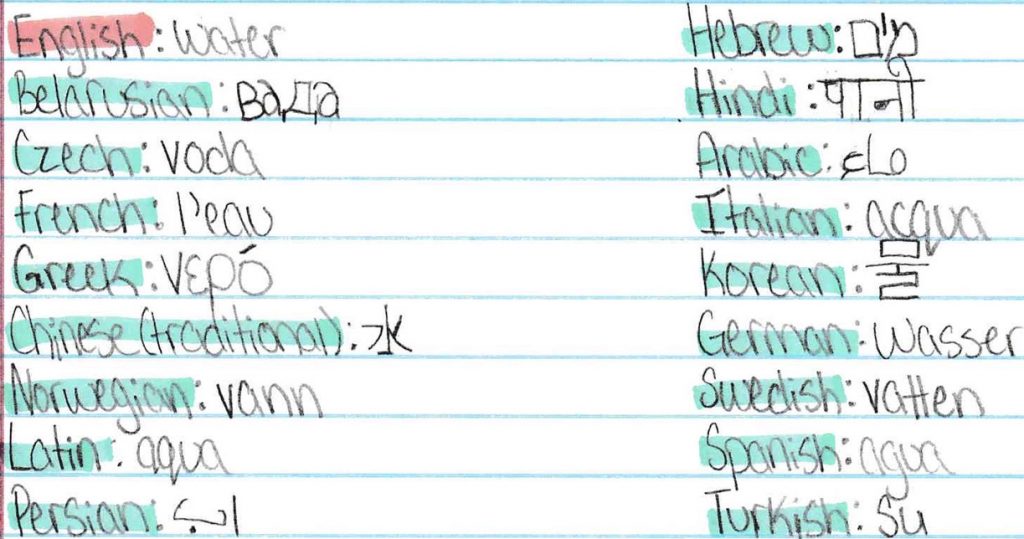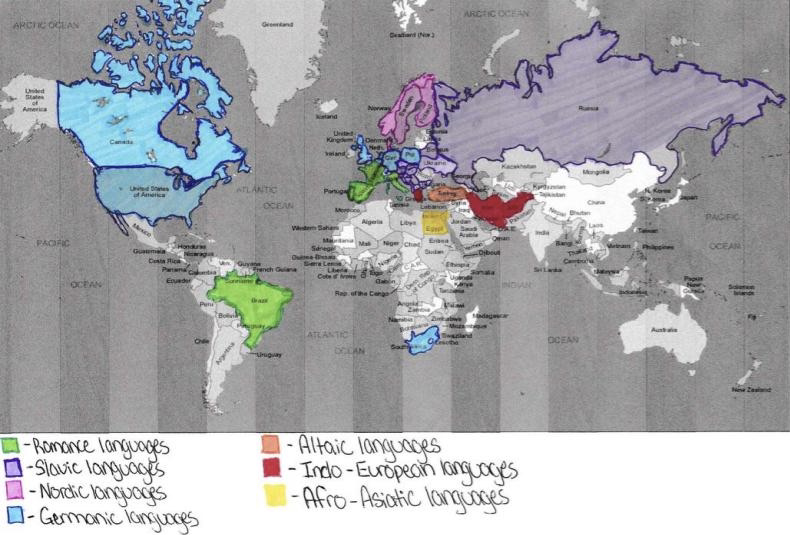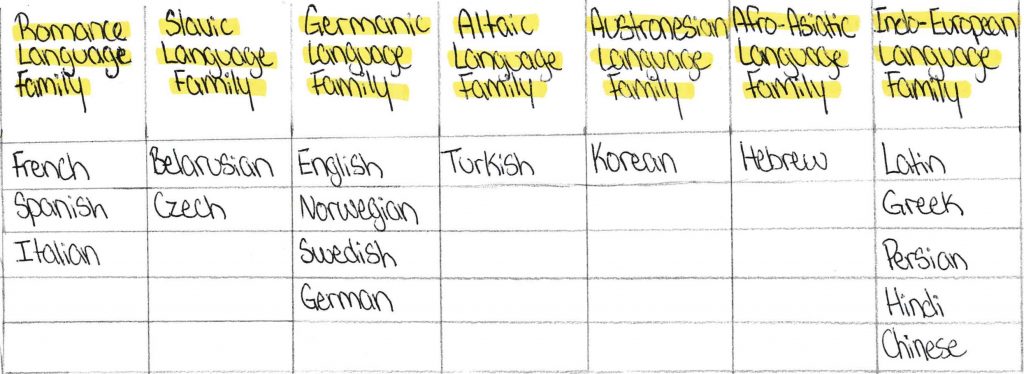
Does the word look/sound the same in some languages?
For some of the languages, the word “water” ended up looking quite similar. The Latin, Spanish, and Italian ways to spell “water” were all very similar with only a change of a few things.
What are some patterns (ie forms of water) you see (or hear) repeatedly? Highlight some of the forms of “water” that appear repeatedly.
The patterns I found for forms of water was between Belarusian and Russian which were almost very similar, with only one symbol looking different. Additionally, a pattern that I noticed was the word “water” for Czech, Swedish, and Norwegian all began with the letter “v”. I am unsure if this is a pattern/relation or more just coincidence but Hindi and Persian both had a vertical line in the spelling of “water” as well.
English uses a writing system called the Roman Alphabet. What other languages use the same writing system as English?
Some of the most common languages that use the Roman Alphabet are French, Spanish, German, Portuguese, Dutch, Turkish, Vietnamese, Bahasa Malay, Bahasa Indonesia, Tagalog, Chinese, and Japanese.
Which languages appear to share other types of writing systems? What are these writing systems called?
The languages Hindi, Marathi, Nepali all appear to use the syllabic alphabets/abugidas writing system. Under this type of alphabet is the Devanagari alphabet where these languages all share a similarity. However, when I chose the languages I would be translating “water” in, I only chose Hindi and not the other two listed. After some research, I discovered that these languages do have some similarities. These similarities are considered to be some of the letters or symbols being used.
What are some characteristics of each writing system (refer to the Omniglot website.)
The characteristics of the abjads/consonant alphabet is that they “have independent letters for consonants and may indicate vowels using some of the consonant letters and/or with diacritics” (Ager, 2021). Additionally, a full indication of vowels is only to be used in a specific context. The alphabet, also known as phonemic alphabets, “are sets of letters that represent consonants and vowels” (Ager, 2021). For syllabic alphabets/abugidas, the “main element is the syllable” (Ager, 2021). For syllabaries, it is a “phonetic writing system consisting of symbols representing syllables” (Ager, 2021). Lastly, there is a semanto-phonetic writing system which often will “represent both sound and meaning” (Ager, 2021). Under this writing system there are also pictograms and logograms, ideograms, and compound characters. There are also undeciphered writing systems which are “writing systems that have yet to be deciphered or have only been partially deciphered” (Ager, 2021).
Where on this map are similar versions of the word “water” found? What does this tell you about cognates? Think about the movement of a water word from one part of the world to another. What historical events in world history might influence the spread of this word? Consider world empires (use Wikipedia or other sources to help you answer this question.)
Similar versions of the word water were found in Brazil, Spain, Portugal, Italy, and France. It is also commonly found to be the same in North America. Additionally, Russia and the countries below which are Ukraine, Belarus, Croatia, Czech Republic, Hungary, and Slovenia. This tells you that there are some cognates within the different countries. Since the word “water” is spelled similarly in other countries and has the same meaning, they would be considered cognates. This also goes to explain that cognates can occur in several different parts of the world. For example, Brazil has a similar version of the word “water” that Spain, Portugal, Italy, and France have. However, Brazil is separated from the other countries by the Atlantic Ocean and other countries. This goes to show that even though Brazil is separated from the other countries that have similar spelling and meaning of “water”, cognates are still able to occur. I feel that a major influence on the similarities might be a result of colonization that occurred years ago. For the Germanic language family, the spread of similar languages is due to British colonization in North America and South Africa. For Brazil, there was Portuguese colonization that also had occurred in the past. Along with colonization, another influence might have been due to the world wars. Additionally, the influence of immigration and migration also have a strong effect on cognates.

used in question #1.


What language families can you find in your lists and labelling?
On the map, I was able to find the following language families: Romance languages, Slavic languages, Germanic languages, Altaic languages, Austronesian languages, Afro-Asiatic languages, and Indo-European languages. Additionally, the Indo-European had an additional three branches of languages. I have included a table organizing the language families and branches.
How can the language awareness you developed today about language families and writing systems help you as a future teacher? Provide some concrete examples.
This helps my future as a teacher because I am able to understand a student’s languages easier and if there are any similarities of it to the English language based on language families. I strongly feel becoming educated on language families allows for me to become a better teacher. For example, if the student speaks German, I might be able to find some similarities between the English and German languages. I would be able to do this because both of these languages belong to the Germanic language family. If my student spoke Spanish, I could use my understanding of the French language to support the student. The French and Spanish languages both belong to the Romance language family and therefore share some similarities. I will definitely be using this assignment as a reference in my teaching in the future. I will be sure that at my desk, I have the map where I have identified several language families as well as the charts that I made.
Additionally, as mentioned in class on January 27, I can ensure that I am never assessing my students in only one language (Khanam, 2021, slide 3). I have begun to develop language awareness through this activity and understand how in some cases, it can become difficult for a student who speaks more than one language. For example, if the student is learning English but speaks a language that is part of the same language family, the similar words or phrases might become difficult. They might begin to mix up the two languages and possibly create more challenges/barriers for the student. Therefore, I will ensure that I am assessing my students in the language that they feel comfortable using.
Reference
Khanam, R. (2021, January 21). CMLA Review [PowerPoint slides].